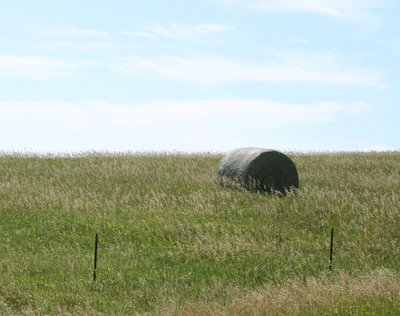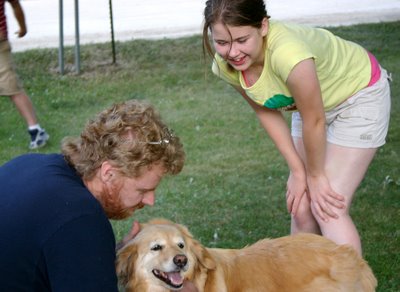Saturday, July 29, 2006
switching shoes
Someone took up the notion of profiling me for the Classic. It's an honor but embarrassing. She said on the phone it was going to be short, but when what you’re reading is about you it all seems ridiculously long.
I understand:
1) How it feels to be asked a question you have no idea how to answer, and then read back what you said and know it wasn’t true.
2) How any little adjective or adverb can cause an entire paragraph to be slightly inaccurate.
3) How we do try to sensationalize everything. This person was the best at this. She loved this. She hated that. She learned this for sure. We try to explain unexplainable people into things as simple as words.
I got to see a draft of the proposed article and, being a finicky editor (it really is shameful), I made so many suggestions that I feel bad sending it back to her. What I was suggesting, though, in my defense, wasn’t grammatical or stylistic or anything. They were all either factual corrections or new ideas for adjectives that would be more accurate.
Thursday, July 27, 2006
You get to spend two years two years learning about research methods, the history of mass media, advanced newspaper design and editing... and editing along the way.
It sounds like bundles of fun to me. Bundles and bundles. But,
1. It costs money. (Or, at least, prevents me from paying loans off so quickly.)
2. I wouldn't get out until I was... 26.
3. Do I really want the hectic life and late hours of a newsroom editor?
4. If the answer to 3 is no but I want to teach college journalism, am I willing to go to school until I'm... 29 or so?
I don't know...
I guess maybe the smart thing to do would be to prepare this fall as if I did want to apply in the winter. If I get in (it is very competitive, but in my vanity getting admitted is a concern at the very bottom of the list), and if I will not be actually adding to my loans... then maybe we'll think some more.
Wednesday, July 26, 2006
http://vontrapped.blogspot.com/2006/03/last-night-von-trapp-gave-me-night-off.html
The main page is http://vontrapped.blogspot.com
(Sorry about the links. Macs + Safari + Blogger = Poor combo, though each are marvelous individually.)
Tuesday, July 25, 2006
Sunday, July 23, 2006
Thursday, July 20, 2006
“Gilead” has won wide acclaim, and it’s worthy of it – at the very least, as a collection of sometimes-random stories.
This morning I have been trying to think about heaven, but without much success. I don’t know why I should expect to have any idea of heaven. I could never have imagined this world if I hadn’t spent almost eight decades walking around in it. People talk about how wonderful the world seems to children, and that’s true enough. But children think they will grow into it and understand it, and I know very well that I will not, and would not if I had a dozen lives. That’s clearer to me every day.
I can’t believe we will forget our sorrows altogether. That would mean forgetting that we had lived, humanly speaking. Sorrow seems to me to be a great part of the substance of human life.
You must not judge what I know by what I find words for.
How can capital-T Truth not be communicable?
I don’t know exactly what covetise is, but in my experience it is not so much desiring someone else’s virtue or happiness as rejecting it, taking offense at the beauty of it.
II. Does anybody remember the name of the Ewazen piece in memory of Sept. 11? It’s beautiful – just listening to it now. Seems like the word “heroes” was in their somewhere.
Confession: Some of my favorite lines are brass lines. There’s the intro solo trumpet (Sarah? Maybe Tim?), and the low brass solo in the middle’s my very favorite (it sounds like a baritone, but maybe it’s Pete) even though it’s about two measures long. I never minded when we had to repeat that section. And the running French Horn lines were lovely, too – VZ, I feel for you guys. It sounds rough. Malinda, do you feel trombones get overlooked a lot? If you’re listening to our recording, I’m the clarinet that keeps squeaking. It was a bad night. There’s one part we rehearsed over and over at the beginning to get the legato or whatever just right.
Next up on the CD is one of Monica’s many solo pieces. Did you hear she got married this last weekend? I guess it was unbearably hot outside.
Now the band/choir combined concert! Can you imagine the fun? :)
Wednesday, July 19, 2006
screw that

Love page design? Maybe not. :) We got the paper back from the printer this morning, and my sports photos are all fuzzy boxes of crap because I forgot to link them to the pages properly.
As you can see, I've initiated a propaganda campaign against myself in attempt to correct this problem in the future.
Tuesday, July 18, 2006
learning as you go...
Today's lesson was several dozen typography terms and tips -- part review and part new knowledge for me. That new knowledge would have come in handy nine hours earlier as I was breaking those laws.
- Thou shall not make widows (single words for the last line of a paragraph);
- Thou shall not make orphans (single lines before an empty line beginning a new column);
- Thou shall align thy baselines (body text should line up from column to column); and
- Thou shall not make rivers (narrower columns of especially loose justified text).
A couple I had heard before but choose to overlook when convenient.
I like the challenge of layout. It's putting together a puzzle with either too many or too few pieces and no indication beforehand what the puzzle's supposed to look like. It does get frustrating, though, when a piece "fits" somewhere but you can't leave it there because it violates design principles. For instance, today: I had a ten-inch tall column with a six inch story and a three inch photo beneath it on the front. One inch was all white, and filler ads aren't allowed on page one...
Monday, July 17, 2006
It takes at least 1 minute and 45 seconds (at least) to edit one photo from its raw form to the version I can use in the paper. The first step for preparing a photo for black and white printing: Get the photo as close to perfect in color as possible.
Black and white printing really can be frustrating. In a large sense it is simpler than color printing because there aren't multiple plates to be lined up perfectly. But on the other hand, you don't know how much ink your printing company is going to use in black and white. You might adjust the brightness and contrast and greys just right for the screen version, but make that version several shades darker all over... and you'll have a photo full of things people guess might be faces. Or your printer could be wary about ink, and you'll have overexposed to compensate for a lot of ink, and then your photos will be really white and lose a lot of definition.I have a lot to learn in the art of black and whites. How do you preserve all the definition and contrast as well as possible?
Sunday, July 16, 2006
Thursday, July 13, 2006
bor-ed
Well, what's new here? Everything and nothing.
Did you know there are no calories in pickles?
The pesky fly in my office disappears if I take out the flyswatter.
The paper two towns north of here plagiarized another one of my stories this week. How do you confront someone about something like that?
I wrote a witty headline this week: "Dentist may fill in downtown cavity." There's a hole in the downtown strip because of a fire and a dentist is going to build a new office there. The pharmacists really liked it.
One of my favorite shirts has gone unnoticed in my closet the entire summer.
All these books listed that I'm "reading"? Psh. When I get to it I'm chipping away at them. I picked up a sequel to "All Creatures Great and Small" last weekend and I can sit and read large chunks of it at a time. If you've never read any of James Herriot's stuff, seriously, it's addictive. I'm sorely disappointed that I can never go live in 1930s Yorkshire as a male veterinarian. They're stories that suck you in and make you laugh out loud and tear up and become good friends with the characters. His characters are amazing. Half of them are farmers with strong Yorkshire accents, and it takes a bit at first to try to figure out the terms. Translating English to English, you know.
Watched "Hotel Rwanda" yesterday. It seems disrespectful to call it a movie. It must have been difficult to review, because if you really wanted to look at it as a film then you might be criticizing it and people will probably think you're evil.
Have I written about my ant infestation? (Sigh.) A large part of my home life. Some days I avoid sitting in my living room at all costs, because occasionally I'll find one crawling on me. My bedroom has become a refuge -- none sighted there yet. (Unfortunately, no AC in there.) Their numbers have been very few in the last few days, but I'm not confident they're really gone. Little cardboard squares of poison are all over.
I have nice moles. On my right leg there's an isoceles triangle of them, all exactly the same size and shade of brown. It's very striking against my pasty skin. Sometimes I connect the dots with a pen for amusement.
Tuesday, July 11, 2006
Wednesday, July 05, 2006
what do you think?
Monday, July 03, 2006
ketching up on the facts
Most ketchup historians, I was amazed to learn (at Wikipedia), classify the origin of the term and the product as either Chinese or Malaysian. The terms “ke-stiap” and “kchap” referred to a pickled fishy sauce in the 1500s. The Dutch and other explorers brought it back home to Europe where the Dutch called it “ketjap.” It makes more sense now why it might be called “catsup,” too.
As time passed the word referred generally to sauce. Some ketchups were made of mushrooms, cucumbers, kidney beans, walnuts or anchovies. Yum yum.
In either England or the U.S., a tomato ketchup materialized by 1800, when the first recipes for it have been found. Those recipes were relatively salty, and the tomato was still rare (and sometimes considered poisonous) back then.
Tomato ketchup only became more and more popular throughout that century. Apparently, some of those early ketchups were pretty watery because they were made of unripe tomatoes, which have less pectin. They were also less likely to contain vinegar. That has remained true of ketchup in most other English-speaking countries, where it is more of a tomato paste.
The most common ingredients in American ketchup today are tomatoes, vinegar, salt, sugar, allspice, cloves and cinnamon.
Ketchup has, for most of its life, been stored in – insert groan here – glass bottles. Scientists tell us that ketchup is a “thixotropic” fluid – which, for all practical purposes, means it doesn’t pour too well.
Next time you’re at a restaurant with one of those irritating glass bottles of the red stuff, try this: Turn the bottle upside down (top on, please) and give it a good couple taps on the neck with your index and middle fingers. Specifically, some caterers say, tap a Heinz 57 on the 57 circle. If you care to know, it helps flow by correcting the G-forces. I’ll just stick with my plastic bottle stored upside-down, thanks.
In 1981, the government considered classifying ketchup as a vegetable for economic reasons in the school lunch program.
Teresa Heinz Kerry, is, yes, tied genealogically to the ketchup company. One of my favorite ketchup books, kids of all ages, is “Mrs. Pig’s Bulk Buy.” It’s about a family of piglets who coat everything they eat with ketchup.

















